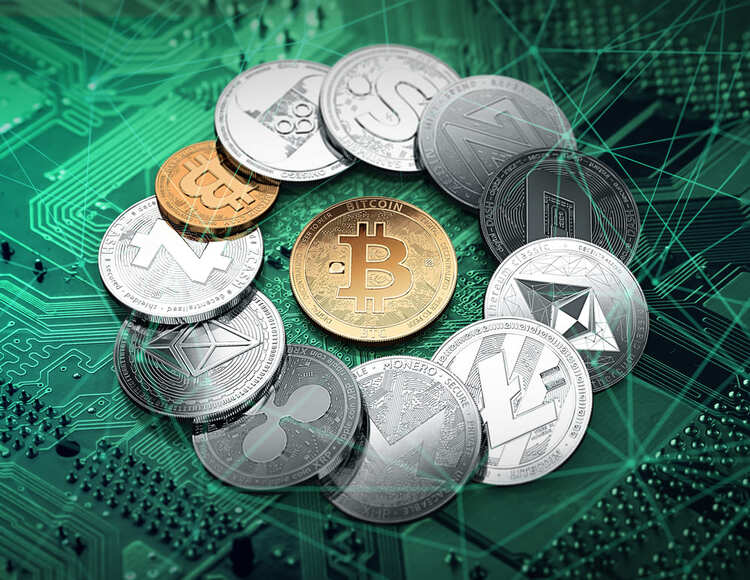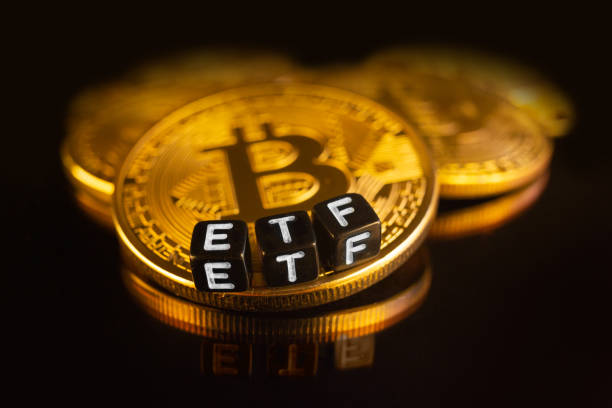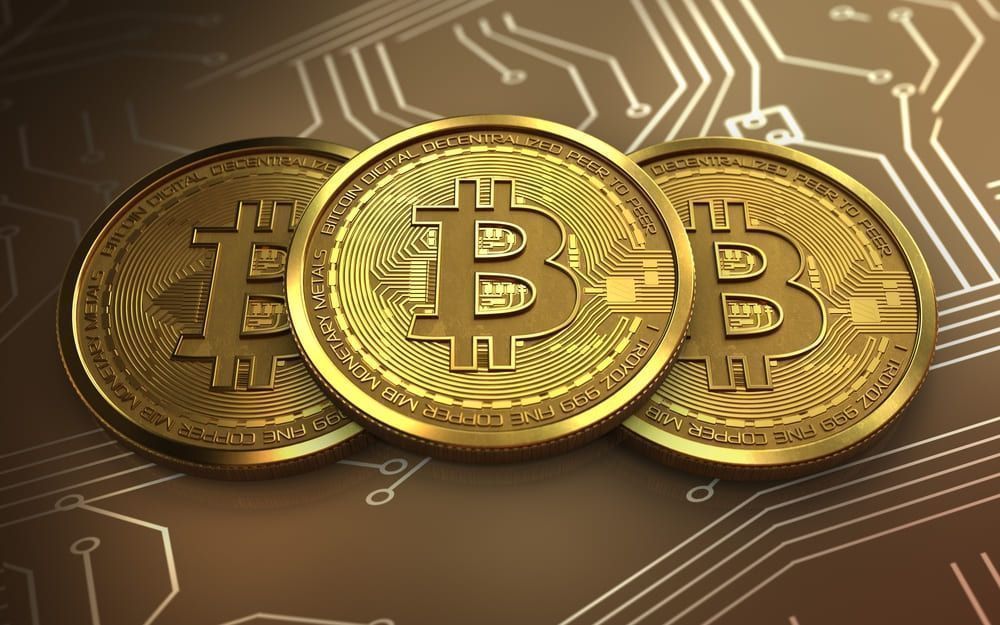What Are Stablecoins — and Could They Replace the U.S. Dollar’s Global Dominance?
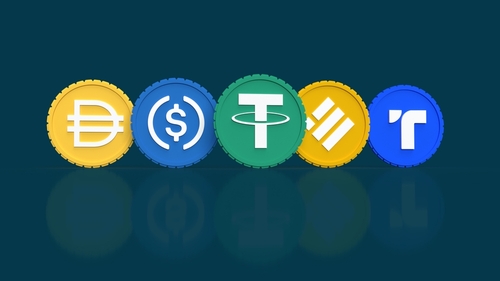
Introduction
In 2025, stablecoins have become a geopolitical flashpoint. The U.S. is advancing the GENIUS Act, the Trump family has launched its own stablecoin USD1, Hong Kong’s Stablecoin Ordinance takes effect in August, and South Korea’s Digital Asset Act has clarified issuance rules. With the global stablecoin market surpassing $250 billion and Circle (CRCL) going public, stablecoins are drawing global attention — and raising questions about their potential to challenge the U.S. dollar’s supremacy.
This article explores the fundamentals of stablecoins, their types, use cases, and whether they could one day rival the dollar as the world’s reserve currency.
What are Stablecoins?
Stablecoin are cryptocurrencies designed to maintain a stable value, typically pegged to a fiat currency (like USD or EUR) or a commodity (like gold). Originally created to reduce crypto volatility, stablecoins now serve as a bridge between traditional finance and blockchain ecosystems.
Compared to fiat currencies or volatile cryptos like Bitcoin (BTC) and Ethereum (ETH), stablecoins offer four key advantages:
Key Features | Description |
Price Stability | Designed to remain stable, making it a reliable medium of exchange and store of value, especially in volatile crypto markets. |
Liquidity & Flexibility | Can be easily traded on exchanges or swapped for other cryptocurrencies, offering high operational flexibility. |
Transparency | Blockchain-based stablecoins allow public verification of transactions, enhancing trust and visibility. |
Fast Transactions | Unlike traditional finance, stablecoin transfers are quicker, enabling efficient cross-border payments. |
Unlike traditional finance, stablecoin transfers are quicker, enabling efficient cross-border payments.
Types of Stablecoins
Stablecoins generally fall into three major categories: Fiat-backed, Crypto-backed, and Algorithmic. Each has different pegging mechanisms, liquidity levels, and decentralization characteristics:
Fiat-backed | Crypto-backed | Algorithmic | |
Examples | USDT, USDC, EURC | DAI, FRAX, LUSD | UST (failed), USDD |
Peg Mechanism | Pegged to USD, EUR, GBP | No collateral | |
Collateralization | 100% | 150%-350% | 0 |
Decentralization Level | Low | High | Medium |
Price Stability | High | Medium | Low |
Liquidity | Best | Moderate | Poor |
They can also be categorized by fiat peg:
- USD Stablecoins: USDT, USDC
- EUR Stablecoins: EURC, EURS
- GBP Stablecoins: VGBP, CGBP
- JPY Stablecoins: GYEN, CJPY
- SGD Stablecoins: XSGD
- CHF Stablecoins: VCHF
Use Cases for Stablecoins
Stablecoins were originally designed to solve volatility issues in crypto markets, but their unique advantages have expanded their applications far beyond the crypto space.
Sector | Use Cases | Example |
Crypto Trading | - Trading pairs on exchanges - Safe-haven asset during market crashes | Most trading pairs use USDT or USDC |
DeFi Finance | - Collateral for lending platforms (Aave, Compound) - Liquidity mining | DAI accounted for 35% of DeFi TVL at peak |
Investment & Fundraising | - STO (Security Token Offering) - VC capital transfers | Tether used USDT to buy Bitcoin mining equipment |
Cross-border Payments | - Instant international remittances - Trade settlement avoiding Swift delays | Nigeria’s P2P USDT trading volume grew 300% YoY |
Corporate Treasury Management | - Funds reallocation for multinational corporations - Inflation hedge in emerging markets | Tesla holds USDC in its treasury |
Payroll Disbursement | - Payments for freelancers and remote workers | Gitcoin pays developers with USDC |
Everyday Spending | - Crypto credit card payments - Merchant transactions | Singapore’s | Singapore’s Foodpanda accepts USDC payments |
Stablecoin Market Growth & Trends
According to CoinMarketCap, as of July 3, 2025, there are 237 stablecoins with a total market capitalization exceeding $250 billion, accounting for 8% of the entire cryptocurrency market.
- USDT (Tether) remains the largest stablecoin, with a $150 billion market cap, controlling 62% of the market.
- USDC (Circle) ranks second, holding $60 billion.
- DAI (MakerDAO) is the leading decentralized stablecoin, valued at $5 billion.
Emerging stablecoins FDUSD, PYUSD, and USD1 are gaining traction:
- FDUSD was launched by Binance (BNB), the world’s largest crypto exchange.
- PYUSD was issued by PayPal (PYPL), a global payments giant.
- USD1 is backed by the Trump family, increasing its political and financial visibility.
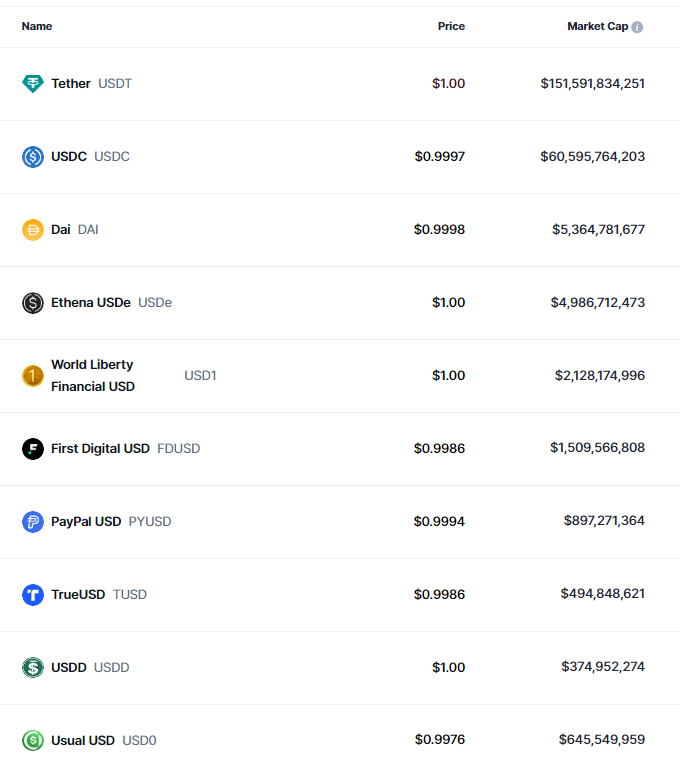
Top 10 Stablecoins – Source: CoinMarketCap.
Will Stablecoins Replace the U.S. Dollar?
Some argue that stablecoins — faster, more transparent, and increasingly adopted — could one day challenge the dollar’s dominance. But most experts say the opposite is happening.
- U.S. Treasury Secretary Bessent has stated that “stablecoins can reinforce the dollar’s global leadership.”
- Former Bank of China VP Wang Yongli noted that U.S. legislation like the GENIUS Act is a strategic move to digitally entrench the dollar’s influence.
- Anthony Scaramucci and Citigroup both argue that USD-backed stablecoins like USDT strengthen the dollar’s reserve status, not weaken it.
From a structural standpoint, USD stablecoins are digital extensions of the dollar, not replacements. They dominate the stablecoin market and account for the vast majority of volume and liquidity.
Unless euro-backed or crypto-collateralized stablecoins gain dominance — a scenario that remains unlikely given U.S. regulatory momentum — stablecoins are more likely to entrench the dollar’s supremacy than replace it.
Conclusion
Stablecoins have proven their value in financial markets, improving liquidity, transaction speed, and global accessibility. However, their chances of replacing the U.S. dollar as the world's reserve currency remain low. Instead, stablecoins strengthen the dollar’s influence by acting as a digital extension of the USD.
While non-USD stablecoins could pose a challenge in the future, the U.S. government’s proactive approach ensures the dollar remains central in the evolving stablecoin ecosystem.




